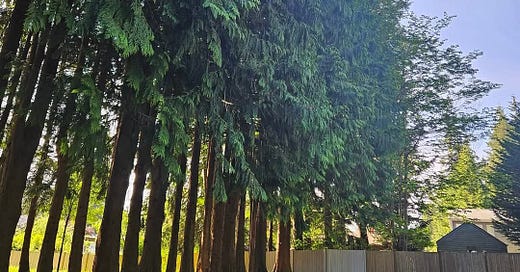I remember the first time I truly saw a tree. Not merely looked at one, but *saw* it in its entirety. I was seven, perhaps eight, wandering alone at the edge of our property where the gate surrendered to wilder things. There stood an old hackberry, its bark furrowed like the face of an elder who had weathered countless storms.
The hackberry stood sentinel at the edge of our yard—not majestic like oaks nor graceful like willows—but perfect in its ordinary strength. Its asymmetrical heart-shaped leaves created a dappled cathedral of light above me as I swung beneath. I placed my small palm against its skin, rough and warm from the afternoon sun. Something stirred within me then—a recognition.
I remember the texture of its bark intimately—rough yet patterned with distinctive corky ridges and warts that my fingers traced like braille, reading the tree's history. The tree did not move to meet my touch, yet I felt welcomed nonetheless. I pressed my ear against its trunk, imagining I could hear the slow coursing of sap like distant music.
When I pressed my ear against its trunk, I heard not emptiness but a quiet humming—the sound of sap rising, of cells dividing, of life persisting despite all that threatened to diminish it.
After thunderstorms, I collected its berries—small orange-red drupes scattered across our yard like lost beads from a broken necklace. They stained my fingers when crushed, released a scent both sweet and sharp. Birds feasted on them while I watched from below, envying their freedom.
The red swing my father built hung from its sturdiest branch, suspended by fraying yellow ropes that left the scent of hemp on my palms. Those ropes smelled of possibility, even on days when possibility seemed remote. My father had built it during one of his sober months, his hands precise with the knots, his voice gentle with promises. I loved him most in those moments, just as I loved him least in others. The hackberry witnessed both without judgment.
The swing creaked beneath me through seasons of growth. The sound became my heartbeat—forward into emptiness, backward into safety, forward again.
That summer, learning to read, I returned daily to that hackberry. I brought books and read aloud to it, convinced that stories fed its roots as surely as rain. When autumn came, I gathered its fallen leaves, pressing them between book pages—preserving pieces of my friend.
I called that first wide branch my porch. From there, I could either retreat higher into the tree's embrace or settle with my back against the trunk, legs dangling, to write. During my teenaged years, my blue three-ringed notebook balanced precariously on my thighs as I scribbled poems about clouds and distant mountains I'd never seen. The hackberry held me steady, its leaves rustling commentary on my adolescent verse.
Sometimes, when my father's voice grew louder in the house, drunk and full of rage, I'd scramble upward to my highest perch—a junction of branches I'd named "the crow's nest." There, forty feet above the chaos, I became invisible.
The hackberry's leaves thickened around me, creating walls of green privacy. Through small windows in the foliage, I watched our house below transform into a dollhouse—problems miniaturized to manageable size.
Even in winter, stripped bare of its camouflage, the hackberry sheltered me. Its naked branches etched stark calligraphy against gray skies while I huddled in my coat, back pressed hard against the trunk. The cold bark against my spine was a reminder: endure, bend without breaking, wait for spring.
Decades passed. Cities claimed me. I learned to navigate concrete forests, to breathe recycled air. But something essential remained dormant, waiting. Then during a particularly harsh summer of the soul, over a thousand miles away, I found myself drawn to a park I had passed a hundred times without entering. A line of sitka spruces stood sentinel along a path. Their mottled bark—patches of cream and olive and brown—peeled away in places like shedding skin. I was transfixed. I had forgotten this feeling: this pull, this quiet communion.
Standing before them, something inside me unfurled. I wept without shame or explanation.
Now I understand. My heart has always spoken the language of trees. My hackberry never asked questions. Never required explanations for tears or silence. It simply existed alongside me, growing its rings while I grew mine.
My love for trees is not strange but essential—a recognition of kin beyond species. In their presence, I am most authentically myself. Years later, my love for all trees remains rooted in that first communion. But it was the hackberry—unexceptional by any arborist's standard—that taught me how sanctuary can be found in the most unlikely embrace.
Trees teach me patience. They remind me that growth is rarely linear, that strength can be both flexible and enduring. How something solid and alive can stand between a child and harm, can transform fear into momentary peace through nothing more than its steadfast presence.
Some might call this dendrophilia. I call it remembering my first and truest love. Even now, when I touch any tree's bark, it is the hackberry's texture my fingers expect to find. My dendrophilia began in those branches—not as an escape from life but as an entrance into it.
A way of learning that love need not be perfect to save you, need not be conventional to be profound. The hackberry showed me how to find joy in simply existing, roots deep, face turned toward the sun, arms open to whatever the sky might bring. The trees were always waiting for me to return.






Oh man, the power of trees! This was beautiful, thank you for sharing. I really recommend The World We Once Lived In by Wangari Maathai— she talks all about the spiritual link between humans and trees